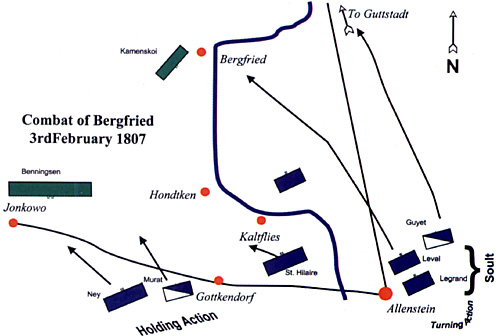Eylau: A Russian View
Battle of Bergfried
by Patrick E. Wilson, UK
| |
The 3rd February would be decisive, and Napoleon for one hoped it would decide the campaign but his troops were still strung out on the march. The morning of the 3rd February saw the French move up to attack, their artillery bombarding the Jonkowo position but they did not commit themselves until 3.00 p.m. It was at this time that Marechal Jean de Dieu Soult attacked Kamenskoi’s 14th Division at Bergfried. That General had positioned his Prussian batteries on a ridge on his left flank that overlooked the bridge that lead to Bergfried over the Alle River. Not that the Alle presented much of a barrier this day as it was frozen solid. According to General Wilson, the British attaché at Russian Headquarters, it was the deep snow that made the Alle difficult to cross. Kamenskoi positioned his infantry partly in but mostly behind the village of Bergfried protecting the defile of his position. The French (General Level’s division of Soult’s 4th Corps d’Armée) started their attack by opening fire with two batteries on Kamenskoi’s Prussian artillery, a third battery fired at his right flank. Meanwhile the 24th Legere launched on attack on the village and bridge, at first repulsed by artillery and infantry fire, a second attack gained the village of Bergfried but not the bridge as Russian skill in the use of the bayonet prevented that. Indeed such was the desperate nature of the fight for the bridge and its causeway that it is a wonder that Bergfried was not retaken. While this fight was in progress, General Vivier had taken his brigade of 4th and 28th Ligne and attempted to cross the Alle to the right of Bergfried. He did not make much progress because of the deep snow and the fact that the Prussian Batteries continued to sweep the embankments with shot and shell. The most the French were able to gain was the village of Bergfried, the corpse-strewn bridge and a precarious foothold on the left bank of the Alle. Soult himself admitted that Level’s division bivouacked that night on the right bank of the Alle with only outposts on the left bank. Losses were heavy on both sides, 600-800 Russians and perhaps as many French. Whilst the combat of Bergfried was in progress, Soult’s cavalry under General Guyot had ridden to Guttstadt, finding it relatively unguarded, Guyot was able to capture a lot of baggage and wounded soldiers. Guttstädt capture also placed the French on Benningsen’s line of retreat. Thus Benningsen found that night that he was severely compromised with Bergfried and now Guttstadt in enemy hands. He had no option but to retreat, this he did at 11.00 p.m. upon Wolfsdorf. Though it was not easy as Wilson recounts: '. . . having to defile through the village of Yonkowo, considerable confusion prevailed, from the darkness of the night, the severity of the weather, and the clashing columns, uncertain of the snow tracts they were to follow, and the carriages etc., which choked up the passage.’ [3]
Benningsen give Bagration command of the rearguard - units under Bagavout, Markov and Barclay de Tolly. With these Bagration remained in position until 9.00
am on 4th February and then began a fighting withdrawal that involved a series of sharp actions at Bergfried, Deppen and Waltersmuhl which brought heavy
casualties upon the pursuing French. By the 4th February Benningsen’s main body had reached Wolfsdorf, he was anxious about the Prussians under L’Estocq
who had only reached Liebstädt and about his own communications with Königsberg and Russia. Early on 5th February Benningsen marched for Frauendorf via Arensdorf, his rearguard under Bagration was not pressed as it had been on the 4th, prisoners stated this was because of the casualties it had inflicted on 4th and because Marechal Michel Ney had been detached to operate against D’Estocq’s Prussians.
Indeed, Ney had engaged and destroyed the Prussian outpost brigades of von Bulow and Maltzahn at Waltersdorf that very day. That night, still fearing for his flank and communications, Benningsen marched off again, this time for Landsberg, which he reached on the 6th February. To cover this march Benningsen detached 3,000 men to Heilsberg to act as a flank guard, these troops were driven from that town by Marechal Louis Davout’s 3rd Corps d’Armée early on the 6th. Along with these Benningsen stationed General Barclay de Tolly a couple of miles south of Landsberg at Hof with orders to gain time for the rest of the Army to get away. Not that the Russian Army wanted to continue the retreat, they wanted to fight! As Wilson makes clear:
'. . . the strongest representations were made by his officers against any further retreat, more prejudicial by actual loss, as they stated, then a severe conflict. The general feeling of the army was not only in unison with such representations, but its expression and general state somewhat alarmingly coincided with these opinions.’ [4]
Eylau: A Russian View by Patrick E. Wilson, UK
|
 On the 2nd February Barclay de Tolly’s advance guard units were withdrawn from Allenstein and the French army began to deploy for an attack on the Jonkowo position, the outlying village of Gottkendorf was taken later that day and the Russian outposts fell back upon their main position.
On the 2nd February Barclay de Tolly’s advance guard units were withdrawn from Allenstein and the French army began to deploy for an attack on the Jonkowo position, the outlying village of Gottkendorf was taken later that day and the Russian outposts fell back upon their main position.